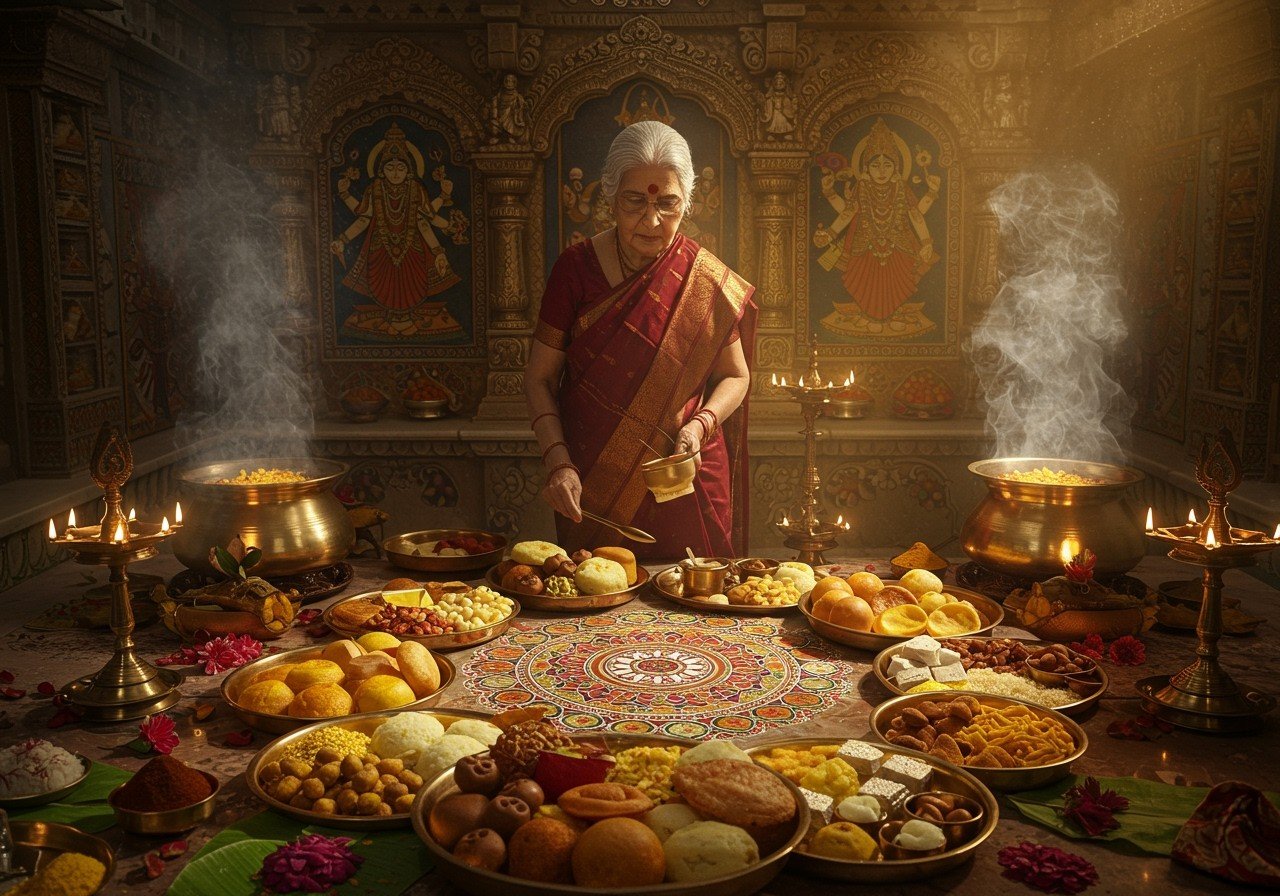
Prasada, the sacred food offering in Hindu temples, holds a special place in our hearts and culture. It’s more than just nourishment; it’s a spiritual connection, a cherished tradition, a link between communities, and a taste of divine grace. For many Indians, especially those who value tradition, Prasada represents a vibrant thread connecting communities and generations. Join us as we delve into the history, spiritual significance, and traditional recipes of temple food, exploring its rich tapestry of flavors and reverence.
A Historical Glimpse into Prasada
Prasada’s roots trace back to ancient Vedic traditions, starting with simple offerings of fruits and grains. Over centuries, these humble offerings transformed into elaborate feasts, reflecting India’s rich regional culinary diversity. Ancient texts like the Puranas shed light on the importance and meticulous preparation of Prasada, highlighting its evolution through time. Royal patronage played a significant role, adding grandeur and variety to Prasada offerings, making them an integral part of festivals and ceremonies.
The Spiritual Significance of Prasada in Hindu Rituals
Prasada is not merely food; it is a sacred offering imbued with spiritual meaning. The act of offering food to a deity transforms it into Prasada, a divine blessing. Devotees believe that partaking in Prasada creates a spiritual connection with the deity, infusing them with divine energy. This symbolic act elevates mundane food into a spiritual gift, a blessing shared by all.
Many temples house “Anna Prasada Kendram” centers dedicated to preparing and distributing Prasada. These centers embody the spirit of community service and unity, fostering a sense of togetherness and equality among devotees. Sharing Prasada becomes an act of gratitude and devotion, a reminder that divine blessings are meant for everyone.
Dharmasthala Prasada: A Beacon of Devotion and Community
Dharmasthala, a revered temple in Karnataka, is renowned for its Prasada offerings. Its unique culinary practices draw thousands of devotees daily, seeking a taste of the divine. The temple’s efficient Prasada distribution system reflects its commitment to community building, serving as a model for others. Dishes like “Chitranna” (lemon rice) and “Sakkare Pongal” (sweet rice), rich in cultural significance, are integral to the Dharmasthala menu. Each dish is a tribute to the region’s culinary heritage. The temple’s commitment to sustainability is evident in its use of locally sourced ingredients, supporting the local economy and preserving traditional recipes.
Temple Food Recipes: A Culinary Exploration of Tradition
Temple food recipes offer a fascinating glimpse into India’s diverse culinary heritage. Authentic dishes like “Pongal,” “Puliyodarai,” and “Payasam” are not just food; they are cherished temple offerings. Their preparation involves traditional ingredients and time-honored methods, carefully preserving their spiritual essence.
-
Pongal, a savory dish of rice and lentils, symbolizes abundance and prosperity, cooked with devotion and shared with joy.
-
Puliyodarai, a tangy tamarind rice, represents devotion and simplicity, a humble offering with deep meaning.
-
Payasam, a sweet dish made with milk and rice, signifies celebration and joy, a sweet ending to a blessed meal.
To recreate these sacred flavors at home, prioritize fresh ingredients and follow traditional techniques, preserving the spiritual essence of Prasada while relishing its rich taste. You can find many of these ingredients, like green mung dal for Pongal, at Poojn.in.
Prasada in the Modern World: Adapting to Contemporary Needs
In today’s fast-paced world, the tradition of Prasada adapts gracefully to modern needs. Online Prasada services offer convenience without compromising authenticity. Virtual temple visits allow devotees to participate in spiritual rituals from afar, maintaining a connection to their roots.
Prasada continues to play a vital role in modern spiritual practices, fostering community connections and grounding individuals in their cultural heritage. Families cherish this tradition, weaving stories and experiences that enrich their spiritual journeys.
For Indians living abroad, Prasada serves as a cultural bridge, providing emotional comfort and a tangible link to their heritage, regardless of geographical distance.
Temple Food: A Mindful, Plant-Based Approach
Temple food, often referred to as Sattvic cuisine, emphasizes a mindful and plant-based approach to cooking. It avoids strong flavors believed to hinder meditation, focusing instead on fresh, seasonal ingredients and minimal seasoning. Traditional temple food often excludes five pungent vegetables: garlic, scallions, onions, chives, and wild leeks.
Here are a few examples of temple food:
-
Dal Bhat: This simple lentil and rice dish, common in Tibetan and Nepali cuisine, is a staple in many temples. Its simplicity reflects the focus on mindful eating and nourishment.
-
Vegetarian Tibetan Momos: These steamed dumplings, filled with fresh vegetables, are a delicious and wholesome offering. Preparing momos can be a meditative practice in itself.
-
Temple Vegetarian Soup: This nourishing soup often features ingredients like konbu (sea kelp), shiitake mushrooms, carrots, taro root, daikon radish, and tofu, subtly seasoned with soy sauce and sesame oil.
Poojn.in: Your Partner in Preparing Temple-Worthy Prasad
At Poojn.in, we understand the significance of Prasada. We make it easier for you to prepare authentic Prasada at home by offering a wide selection of high-quality ingredients and traditional items.
Essential Prasad Items Available at Poojn.in:
-
Pure Ghee: Sourced from certified dairies, ensuring purity for your sweet offerings. Browse our selection of pure ghee for the perfect touch.
-
Sweeteners: Raw sugar (mishri) and rock candy (dhaga mishri) for naivedya, adding sweetness to your devotion. Check out our range of sacred ingredients, including mishri.
-
Traditional Vessels: Copper and brass vessels for offering prasad, adding a touch of tradition to your rituals.
-
Ready-to-Use Ingredients: Elaichi, kesar, and dry fruits for preparing various Prasad dishes, simplifying your process.
-
Prasad Thalis and Bowls: Silver and brass thalis and bowls designed specifically for offering Prasada. These beautiful pieces add a touch of reverence to your offerings.
Why Choose Poojn.in?
-
Quality Assurance: Quality-checked ingredients from reliable and trusted sources.
-
Authenticity: We offer authentic materials that meet traditional specifications.
-
Convenient Delivery: Pan-India delivery ensures you receive your Prasad items right at your doorstep.
-
Competitive Pricing: We offer competitive prices and regular discounts.
-
Expert Guidance: Our team provides expert guidance on product selection to help you make the right choices.
Visit www.poojn.in today to explore our collection and experience the convenience of online shopping for all your puja needs.
Embracing the Timeless Tradition of Prasada
Prasada transcends time and place, nourishing not just our bodies but also our spirits. It reminds us of our shared traditions and values, connecting us to something larger than ourselves. Whether you’re experiencing Prasada in a temple or recreating it in your home, it’s a reminder of the divine in everyday life.
Embrace the timeless tradition of Prasada, a celebration of faith, unity, and cultural richness. Let it inspire you to explore and preserve these rituals, ensuring the spirit of community and devotion thrives for generations to come. For more information on cultural traditions and rituals, explore our insightful blog posts like Hinduism, Food, Annapoorna, and Divine Nourishment: A Sacred Relationship and Kerala’s Sacred Foods: Sattvic Cuisine and Temple Rituals.


